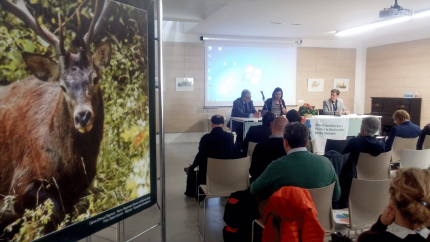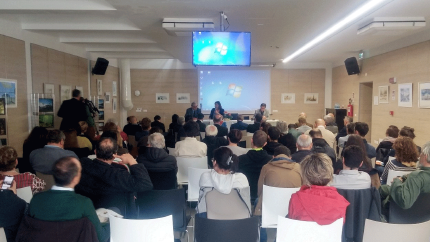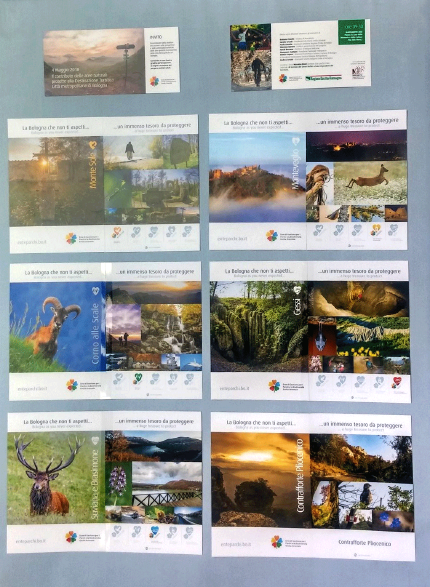The contribution of the Protected Natural Areas to the Tourist Destination of the Metropolitan City of Bologna
A public meeting was held in Marzabotto (Bologna) on 4 May 2018 entitled "The contribution of the Protected Natural Areas to the Tourist Destination of the Metropolitan City of Bologna".
The meeting was chaired by Massimo Rossi, director of the Management Agency of the Emilia-Emilia Parks (public body that manages No. 5 Regional Parks: Corno alle Scale, Suviana and Brasimone Lakes, Monte Sole, Monteveglio Abbey, Bologna Gypsums and Abadessa Badlands, plus the Pliocenic Rocky Buttress Nature Reserve). The speakers pannel was composed, on one hand, by Sandro Ceccoli, president of the Ente Parco, Romano Franchi, mayor of the Marzabotto municipality, Vincenzo Barone, of the company Eco & Eco (who presented the study on the "Visitor economy" in the protected areas of the conference), Patrick Romano and Giovanna Trombetti, directors respectively of Bologna Welcome and of the newborn " Touristic Destination Bologna Metropolitana" (who began to design new tourism products in order to transfer part of the tourist flow that today focuses on historical center of Bologna, throughout the metropolitan area and that, to this end, for 2019 will create a tourist reception point in the historical, dedicated exclusively to the tourist offer of the parks and the Apennines).
Other presenters that followed were Giampiero Sammuri, president of Federparchi and of the National Park of the Tuscan Archipelago (which presented the model of management of the excursion flows on the territory of the Park and remembered how valuable the role of the Environmental Excursion Guides), as well as two regional councilors: Paola Gazzolo (Councilor for the Defense of Soil and Civil Protection) and Andrea Corsini (Councilor for Tourism), who highlighted how, while once parks could be considered an added value of the tourist offer, today they represent a structural element. Vinicio Ruggeri, president of the regional CAI and representatives of local agricultural associations also took part.

Presentations during the meeting - Photo by Emilia Romagna Region
One theme on which all the speakers agreed was that we need to overcome the dichotomy between territorial protection and economic development: the two needs, in fact, can not only coexist but the protection of biodiversity can become a key element to be enhanced in the construction of tourism products. In the last decade, with no special promotion interventions and consequently in an almost "unexpected" way, thanks to the natural evolution of national and international “incoming” tourism wishes and destinations, the Emilia Romagna Apennines became the subject of an ever-increasing interest (requires), especially as regards the "paths", the best known of which, the Via degli Dei (God’s Way), promoted on private initiative, currently sees a target of 20-25'000 hikers / tourists a year and to which has still paid a service offer appropriate to this request. Moreover, to this destination, in the territory of the Metropolitan City of Bologna are being added other routes such as: Via del Gesso, Gothic Line, Parks High Trail, Small Cassia way, Flaminia Minor way, St. Anthony's Way, Chestnut and Brown Land, 5 Valleys Crossing, Wool and Silk Way, Eno-Gastronomical Itineraries of the Apennines and others.

General view of the meeting - Photo by Emilia Romagna Region
During the conference it was recognized that the Protected Areas can be a key element of this tourism relaunch (and related socio-economics recovery), and that this huge tourist potential must be accompanied by an offer of adequate tourist services, a well maintained and reported hiking network, efficient logistics services (functional both to tourists but also to the local population) and a set of proposals able to offer tourists an all-round experience on the peculiarities (even the eno-gastronomic) of the territories they visit or pass through.

information pannel - Photo by Emilia Romagna Region
All this development must no longer be in contrast with the objectives of protecting environments and biodiversity; vice versa, the tourist interest must be not only for the benefit of local communities but also to allow interventions of protection, protection and enhancement not only within the Protected Areas but in all the territories that connect them, which must be seen as an “environmental continuum”. To this end, education for sustainable tourism and the provision of quality tourist support services will play a key role.
